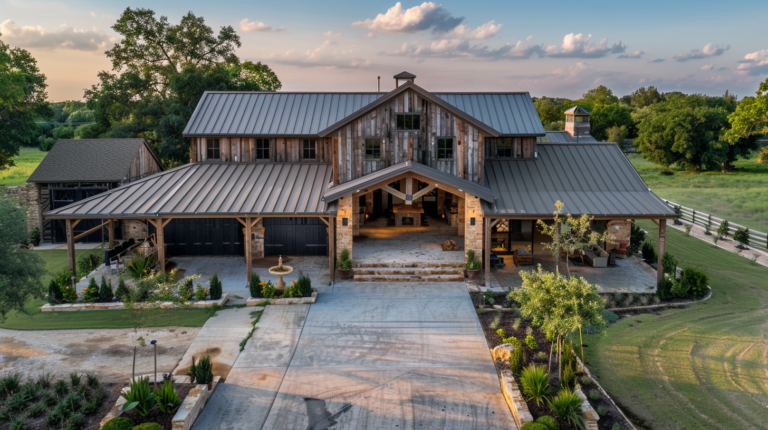Radiant Heat Flooring For Your Barndo | Everything You Need to Know
In the quest for comfortable, efficient, and aesthetically pleasing heating solutions, radiant heat flooring emerges as a standout option for barndominiums. Unlike traditional heating systems that rely on air circulation to warm a space, radiant heat flooring offers an innovative approach by directly heating the floor surface, radiating warmth throughout the room for a cozy, even temperature.
This method not only enhances the comfort of living spaces but also introduces significant energy savings and health benefits.
As homeowners increasingly seek sustainable and cost-effective heating solutions, radiant heat flooring stands out for its ability to blend seamlessly into any design aesthetic while providing unparalleled comfort and efficiency.
| Key Takeaways | Details |
|---|---|
| Types of Systems | Electric systems are suited for small areas or supplemental heating, while hydronic systems are best for larger spaces or whole-house heating. |
| Installation Considerations | Proper insulation and subfloor preparation are crucial for maximizing efficiency and ensuring even heat distribution. |
| Compatible Flooring Materials | Tile, stone, and certain laminates and engineered woods are best for radiant heat, due to their thermal conductivity. |
| Cost Analysis | Electric systems have lower initial costs but higher operating costs, whereas hydronic systems have higher upfront costs but are more efficient in the long run. |
| Efficiency Maximization | Using programmable thermostats, enhancing insulation, and performing seasonal adjustments can significantly improve system efficiency. |
| Health and Environmental Benefits | Improved indoor air quality and reduced carbon footprint make radiant heat flooring an eco-friendly choice. |
| Troubleshooting Common Issues | Issues like uneven heating or system malfunctions often stem from installation errors, air in lines, or thermostat problems. |
| Future Trends | Technological advancements and integration with smart home systems are expected to enhance the functionality and efficiency of radiant heat flooring. |
| Sustainable Living | The use of renewable energy sources with hydronic systems further reduces the environmental impact and supports sustainable living practices. |
| Popularity and Investment | Growing awareness and the push towards energy efficiency are increasing the popularity of radiant heat flooring, making it a smart investment for the future. |
Section 1: Understanding Radiant Heat Flooring
Definition and How It Works
Radiant heat flooring is a system that allows heat to rise naturally from the floor, warming a room evenly and efficiently. There are two main types of radiant heat systems: electric and hydronic. Electric systems use electric cables or mats installed beneath the floor surface to generate heat, while hydronic systems circulate heated water through a network of pipes. Both systems turn the floor into a large, low-temperature radiator, ensuring consistent heat distribution without the noise and drafts associated with forced-air heating.
Historical Background and Evolution
The concept of radiant heating is far from new, tracing back to ancient Rome, where hot air was circulated under the floors of public baths and private villas. Modern radiant heat flooring, however, has evolved significantly, incorporating advanced technologies to improve efficiency and ease of installation. Today’s systems are designed with the contemporary homeowner in mind, offering a blend of tradition and innovation for an optimal heating solution.
Components of a Radiant Heat Flooring System
A radiant heat flooring system consists of a heat source (electric cables or a boiler for hydronic systems), a distribution system (electric mats or water pipes), and a thermostat. The thermostat plays a crucial role in regulating the system’s temperature, ensuring that the floor delivers consistent and comfortable warmth. For hydronic systems, additional components such as pumps and valves are necessary to circulate the heated water.
Section 2: Benefits of Radiant Heat Flooring
Energy Efficiency and Cost Savings
One of the most compelling advantages of radiant heat flooring is its energy efficiency. By directly heating the living space from the ground up, radiant systems minimize heat loss, making them more efficient than traditional heating methods. This efficiency translates to significant cost savings on energy bills over time, with electric systems being particularly cost-effective for small areas and hydronic systems offering savings for larger spaces.
Comfort and Consistent Heat Distribution
Radiant heat flooring provides a unique comfort experience, warming the entire floor surface evenly. This eliminates the cold spots and fluctuating temperatures common with forced-air systems, ensuring a consistent and cozy environment. The gentle, even heat distribution also means that the system can operate at a lower temperature while achieving the same level of warmth, further enhancing its efficiency.
Health Benefits: Better Air Quality and Hypoallergenic
Unlike forced-air systems that can circulate dust, allergens, and other airborne particles, radiant heat flooring provides a cleaner and healthier living environment. By reducing the movement of air within a space, it minimizes the disturbance of dust and allergens, making it an ideal heating solution for allergy sufferers. The absence of radiators and air vents also contributes to a cleaner aesthetic and easier maintenance.
Aesthetic Advantages: Hidden Heating System
Radiant heat flooring is virtually invisible, with no need for unsightly radiators or vents. This allows for greater freedom in interior design and furniture placement, enabling homeowners to create their ideal living spaces without the constraints of accommodating a heating system. The hidden nature of the system also adds to the clean, minimalist aesthetic preferred in many modern homes.
Longevity and Durability
Designed to last, radiant heat flooring systems are built with durability in mind. Electric systems are particularly low maintenance, while hydronic systems, with proper installation and care, can provide efficient heating for decades. The longevity of these systems, combined with their energy savings and health benefits, makes radiant heat flooring a smart investment for any homeowner.
Radiant heat flooring represents a fusion of comfort, efficiency, and design flexibility, making it an increasingly popular choice for homeowners seeking a superior heating solution. With its roots in ancient heating practices and its eyes on the future of home comfort, radiant heat flooring offers a sophisticated, practical, and health-conscious alternative to traditional heating methods.
Section 3: Installation Process
Pre-installation Considerations
Before installing radiant heat flooring, it’s essential to determine which system best suits your needs: electric or hydronic. Electric systems are typically easier and less costly to install, making them ideal for smaller areas or for use as supplemental heating. Hydronic systems, while more complex and expensive upfront, are more cost-effective for heating larger spaces and can be integrated into a home’s existing hot water system.
Assessing your home’s suitability for radiant heat flooring involves evaluating the insulation and subflooring conditions. Proper insulation is crucial to maximize the efficiency of the radiant heating system and minimize heat loss. Additionally, the type of subflooring can affect the choice and installation process of the radiant heating elements.
Step-by-Step Installation Guide
The installation process varies between electric and hydronic systems but generally follows these steps:
- Subfloor Preparation: Ensure the subfloor is clean, dry, and level. For renovations, remove any existing flooring as necessary.
- Insulation Layer Installation: Install an insulation layer to prevent heat loss downwards, which is especially important for hydronic systems.
- Heating Element Installation: Lay out the electric mats or hydronic tubing according to the floor plan and manufacturer’s instructions.
- Electrical or Plumbing Connections: For electric systems, connect the mats to the power supply. For hydronic systems, connect the tubing to the boiler and install the pump and thermostat.
- Flooring Installation: Once the heating elements are in place, install the flooring material over them, ensuring it’s compatible with radiant heating.
Tips for Successful Installation
- Conduct a heat loss calculation to determine the heating system’s size and capacity.
- Choose a flooring material that conducts and withstands heat well.
- Consider professional installation for hydronic systems due to the complexity of the plumbing work involved.
Section 4: Types of Flooring Compatible with Radiant Heating
Best Flooring Materials for Radiant Heat
- Tile and Stone: Excellent heat conductors and retain warmth efficiently, making them the top choice for radiant heat systems.
- Concrete: Ideal for industrial or modern aesthetics, concrete floors work well with radiant heating due to their thermal mass.
- Laminate and Engineered Wood: These materials can be suitable for radiant heat, provided they’re designed for such use. Avoid solid hardwoods that are prone to warping.
Factors Affecting Flooring Choice
- Thermal Conductivity: Materials with high thermal conductivity distribute heat more evenly and efficiently.
- Thickness: Thicker materials can hinder heat transfer, while too thin materials may not adequately protect the heating elements.
- Environmental Conditions: Consider humidity and temperature fluctuations, which can affect certain flooring materials over time.
Section 5: Cost Analysis
Initial Setup Costs
Electric radiant heating systems generally have lower initial costs than hydronic systems but are more expensive to operate, making them best suited for smaller areas. Hydronic systems, while more costly upfront, are more efficient for heating larger spaces or entire homes.
Operating and Maintenance Costs
Operating costs depend on the type of system, the cost of electricity or fuel in your area, and how well your home is insulated. Regular maintenance for hydronic systems includes checking the boiler and pumps, while electric systems are virtually maintenance-free.
Return on Investment Analysis
Although the initial investment can be significant, especially for hydronic systems, the energy savings over time can offset these costs. Additionally, radiant heat flooring can increase a home’s value due to its efficiency and appeal to potential buyers.
Section 6: Maximizing the Efficiency of Radiant Heat Flooring
Optimal Thermostat Settings
Using a programmable thermostat can help maintain consistent temperatures and reduce energy consumption by adjusting the heat according to your schedule and needs.
Insulation and Energy-saving Tips
Enhancing your home’s insulation can significantly reduce heat loss, making the radiant heating system more efficient. Pay special attention to walls, ceilings, and windows to ensure that they are well insulated.
Seasonal Adjustments and Maintenance
For hydronic systems, seasonal maintenance may include checking the boiler pressure, inspecting the pumps, and ensuring the system is free of leaks. For both electric and hydronic systems, adjusting the thermostat settings seasonally can help maintain comfort while conserving energy.
By carefully selecting the right system, preparing for installation, choosing compatible flooring, and following best practices for operation and maintenance, homeowners can enjoy the myriad benefits of radiant heat flooring—comfort, efficiency, and aesthetic appeal—all while maximizing their investment.
Section 7: Health and Environmental Impact
Radiant heat flooring not only offers comfort and efficiency but also has significant health and environmental benefits. Its operation results in better indoor air quality since it doesn’t rely on forced air that can circulate dust, allergens, and other airborne particles. This aspect makes it an excellent choice for individuals with allergies or respiratory issues. Additionally, because radiant heating systems operate more efficiently and at lower temperatures than traditional heating systems, they reduce energy consumption, which in turn decreases the carbon footprint associated with heating homes.
Reducing Carbon Footprint
By using less energy to achieve the same level of warmth, radiant heat flooring systems contribute to a reduction in greenhouse gas emissions. This is particularly true for hydronic systems that can be powered by renewable energy sources, such as solar water heaters, further minimizing the environmental impact.
Sustainable Living
Incorporating radiant heat flooring into a home aligns with sustainable living principles. The durability and efficiency of these systems, coupled with their compatibility with renewable energy sources, make them an attractive option for eco-conscious homeowners.
Section 8: Troubleshooting Common Issues
Despite the reliability of radiant heat flooring, homeowners may occasionally encounter issues. Understanding how to troubleshoot these problems can ensure the system continues to operate efficiently.
Uneven Heating
If certain areas of the floor are not heating as expected, it could be due to improper installation, air trapped in hydronic lines, or issues with the heating elements in electric systems. For hydronic systems, bleeding the lines to remove air can resolve this issue. For electric systems, checking for damage or disconnections in the heating mats or cables may be necessary.
Thermostat Problems
A malfunctioning thermostat can lead to heating issues. If the floor isn’t heating properly, verify the thermostat’s settings and ensure it’s functioning correctly. Sometimes, simply resetting the thermostat or replacing batteries (if applicable) can fix the problem.
System Not Heating
If the radiant heating system is not working at all, check for power supply issues (in electric systems) or boiler problems (in hydronic systems). Ensuring that all connections are secure and that the system has power or that the boiler is operational can often remedy the issue.
Section 9: Future of Radiant Heat Flooring
The future of radiant heat flooring looks promising, with advancements in technology and materials making these systems more accessible, efficient, and versatile. Innovations in smart home technology are expected to enhance the functionality and user-friendliness of radiant heating systems, allowing for more precise control over home heating and further energy savings.
Technological Innovations
Emerging technologies, such as improved thermal conductors and more efficient boilers and heating elements, are set to enhance the performance of radiant heat flooring. Additionally, integration with smart home ecosystems will enable homeowners to manage their heating systems more effectively, optimizing comfort and energy usage.
Growing Popularity
As awareness of the benefits of radiant heat flooring spreads, its popularity is expected to grow. This trend is likely to be supported by a growing emphasis on sustainable living and energy efficiency in home construction and renovation projects.
Conclusion
Radiant heat flooring represents a significant advancement in home heating technology, offering a multitude of benefits over traditional heating methods. Its ability to provide consistent, efficient, and comfortable heat, coupled with its health and environmental advantages, makes it an excellent choice for modern homeowners.
By understanding the types of radiant heat flooring available, the installation process, and how to maximize efficiency, homeowners can enjoy the comfort and savings provided by these systems for years to come.
As technology advances, radiant heat flooring is set to become an even more integral part of sustainable, comfortable living spaces, making it a wise investment in the future of home heating.







